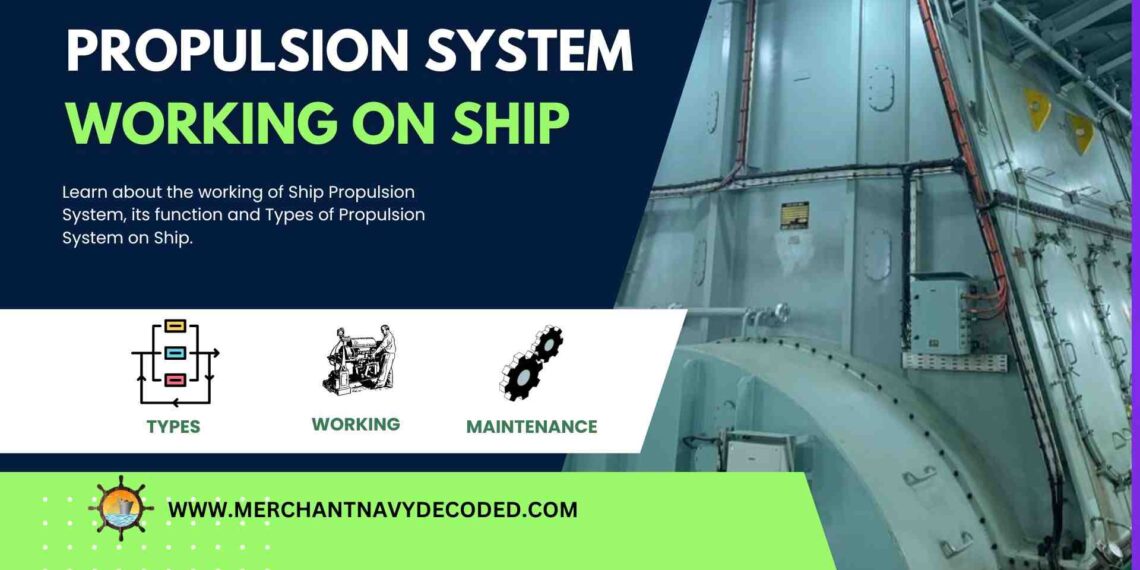Ship Propulsion System | Types of Propulsion System in Ship
1:- Ship Propulsion System Overview
The ship propulsion system is an essential component of machine that provides ships with the power they need to go across the seas. Ship propulsion systems allow the efficient movement of ships by converting the energy from fuels into mechanical force.
The ship propulsion system has changed significantly, reflecting advancements in environmental sustainability, efficiency, and modification to various ship designs.
Two-stroke dual-fuel engines commonly used on ships have the designs and capabilities to offer significant advantages in efficiency, performance, and fuel flexibility.
Several important propulsion methods are currently widely employed in the marine industry, including:
- Diesel Engines
- Gas Turbines
- Steam Turbines
- Electric Propulsion
- Hybrid Systems
2:- Understanding Two-Stroke Diesel Engines
Two-stroke diesel engines differ from their four-stroke counterparts by completing a power cycle in just two strokes of the piston, resulting in more power strokes per cycle.
This feature contributes to their high power-to-weight ratio, making them particularly well-suited for marine applications.
2.1:- Key Characteristics of Two-Stroke Diesel Engines
- In a two-stroke diesel engine, the combustion process occurs with every rotation of the crankshaft, maximizing power output. Operational efficiency is particularly beneficial for ships requiring high thrust for propulsion.
- Two-stroke engines are often lighter and more compact. This design advantage is vital for marine vessels where weight and space are at a premium.
- Two-stroke engines utilize a scavenging process, which replaces exhaust gases with fresh air. This can be achieved through:
- Port Scavenging: Utilizing openings in the cylinder walls.
- Piston Porting: Where the piston uncovers ports during its stroke.
- Fuel Flexibility: These engines can operate effectively on a variety of fuel types, including lower-quality fuels, enhancing their economic viability in maritime operations.
Want to learn more about a ship’s propulsion system? Why don’t you check out our Dreamer Package, which not only has lessons about 2- 2-stroke engines but also lessons about 4-stroke, IC Engine Lubrication, VCRS, and many other essential component of the ship’s engine?
3:- What is a Dual-Fuel Engine
The dual-fuel engine is an advancement in marine propulsion technology, allowing vessels to operate on two different types of fuel—typically heavy fuel oil and natural gas.
Fuels used in dual-fuel engines:
- Heavy Fuel Oil (HFO)
- Natural Gas
- Marine Diesel Oil (MDO)
- Biofuels
- Liquefied Petroleum Gas (LPG)
3.1:- Key Characteristics of Dual-Fuel Engines
- Environmental Benefits: By using natural gas, dual-fuel engines can significantly reduce emissions of sulfur oxides (SOx), nitrogen oxides (NOx), and particulate matter.
- Fuel Flexibility: Operators can switch between fuels based on availability and cost, optimizing operational expenses and ensuring continuous operation.
- Efficiency: Dual-fuel engines can achieve higher thermal efficiencies than traditional engines, improving overall fuel economy and reducing the carbon footprint.
- Operational Reliability: These engines are designed to seamlessly transition between fuel types, ensuring reliability even when switching fuels mid-operation.
4:- Advantages of Two-Stroke Dual-Fuel Engines
- Higher Efficiency: Two-stroke dual-fuel engines offer greater thermal efficiency, reducing fuel consumption—a critical factor in maritime operations where fuel costs can be significant.
- Reduced Weight: The lighter structure of two-stroke engines, combined with the adaptability of dual-fuel engines, enables vessels to carry more cargo or achieve better speed and maneuverability.
- Durability: With fewer components to wear out in two-stroke designs and the versatility of dual-fuel systems, both types tend to have longer operational lifespans, making them reliable choices for marine propulsion.
5:- Types of Marine Propulsion Systems Used On Ship
5.1:- Diesel Propulsion
- Diesel propulsion remains the most widely used system in the maritime industry due to its efficiency and reliability. It converts thermal energy into mechanical energy, making it ideal for vessels from small boats to large commercial ships.
- Applications: The diesel propulsion system is the most commonly used and effective in cargo ships, tankers, and passenger vessels.
- Advantages: High efficiency, great performance, and proven technology.
- Disadvantages: Significant CO2 emissions and dependency on fossil fuels.
5.2:- Nuclear Propulsion
- Nuclear power propulsion systems are primarily used in naval vessels, as they provide enormous energy output and allow ships to operate for long periods without refueling. It uses nuclear reactors to generate steam, which then powers turbines.
- Applications: Submarines, aircraft carriers, and some icebreakers run by nuclear power propulsion systems.
- Advantages: Long operational range and high power.
- Disadvantages: High cost, complex safety concerns, and limited to military use.
5.3:- Gas Turbine Propulsion
- Gas turbine systems, similar to jet engines, are used in fast-moving naval and commercial vessels. These turbines burn gas or liquid fuel to generate thrust.
- Applications: Naval ships, high-speed ferries, and luxury yachts use gas turbine systems because of their high power-to-weight ratio, quick startup, and silent nature.
- Advantages: High power-to-weight ratio, quick start-up.
- Disadvantages: Lower fuel efficiency compared to diesel engines, and high operating costs.
5.4:- Fuel Cell Propulsion
- Fuel cell propulsion is an emerging technology that uses hydrogen to generate electricity through a chemical reaction, eliminating combustion. This system is highly efficient and environmentally friendly.
- Applications: Fuel cells is still in the experimental stage, with potential use in small to medium-sized vessels.
- Advantages: Zero emissions, and high efficiency.
- Disadvantages: Expensive technology, and challenges in hydrogen storage and distribution.
5.5:- Steam Turbine Propulsion
- Steam turbines, once the dominant propulsion system, are now mostly obsolete in commercial shipping but still in use in some specialized vessels like LNG carriers. These systems convert steam energy into mechanical work to drive the ship.
- Applications: Steam turbines are used on LNG carriers and some naval vessels.
- Advantages: High power output.
- Disadvantages: Inefficiency at low speeds, high maintenance.
5.6:- Diesel-Electric Propulsion
- Diesel-electric propulsion system combines diesel engines with electric generators to drive electric motors, providing a versatile and efficient propulsion system. It’s commonly used in submarines and cruise ships.
- Applications: Diesel-electric propulsion is used on submarines, cruise ships, and icebreakers.
- Advantages: High efficiency, flexibility, and reduced noise.
- Disadvantages: High initial costs, and complex system integration.
6:- Conclusion
- Two-stroke diesel engines and dual-fuel engines are integral to marine propulsion systems, offering unmatched efficiency, reliability, and flexibility.
- The efficiency and sustainability of shipping have greatly increased with the development of marine propulsion technologies.
- Every propulsion technology—from hybrid systems to diesel engines—meets the various demands of the maritime sector.
- The development of greener and more efficient propulsion systems is being driven by environmental concerns.
- Propulsion technology advancements will be essential for raising fuel economy and cutting emissions.
The marine industry will continue to be essential and sustainable for international trade and transportation as long as cutting-edge propulsion technologies are used.
7:- FAQ regarding Ship Propulsion System
The engine that propels a ship forward and allows it to go across the water is called a marine propulsion system.
Gas turbines, electric propulsion, diesel engines, and hybrid systems are the primary varieties.
Steam turbines are efficient, low-maintenance, and ideal for large vessels needing durability and quick power shifts.
Gas turbines are renowned for their versatility, rapid start-up times, and high power-to-weight ratio. They work especially well on fast ships, like military boats, where agility and quickness are vital.
While gas turbines perform well in applications needing quick power changes and less weight, steam turbines are often more efficient for purposes requiring continuous power. The decision is based on the particular needs of the vessel’s operation
Disclaimer :- The opinions expressed in this article belong solely to the author and may not necessarily reflect those of Merchant Navy Decoded. We cannot guarantee the accuracy of the information provided and disclaim any responsibility for it. Data and visuals used are sourced from publicly available information and may not be authenticated by any regulatory body. Reviews and comments appearing on our blogs represent the opinions of individuals and do not necessarily reflect the views of Merchant Navy Decoded. We are not responsible for any loss or damage resulting from reliance on these reviews or comments.
Reproduction, copying, sharing, or use of the article or images in any form is strictly prohibited without prior permission from both the author and Merchant Navy Decoded.




